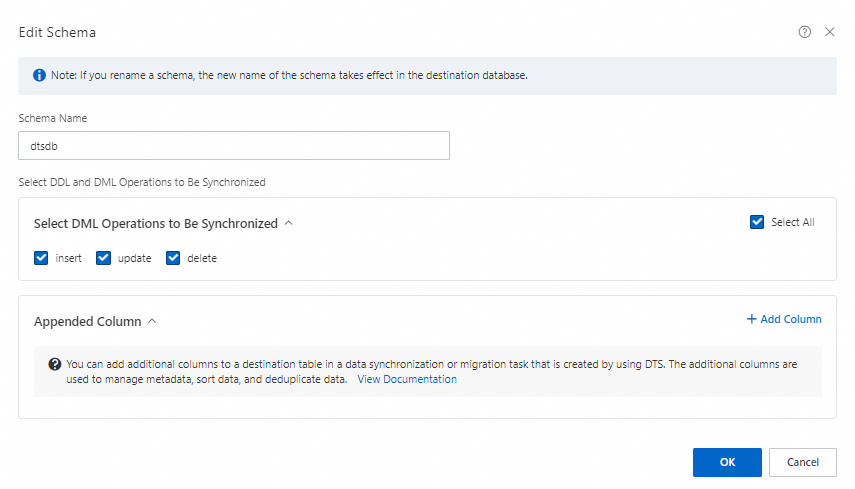Configuration |
Description |
Dedicated Cluster for Task Scheduling |
By default, DTS schedules the data migration task to the shared cluster if you do not specify a dedicated cluster. If you want to improve the stability of data migration tasks, purchase a dedicated cluster. For more information, see What is a DTS dedicated cluster.
|
Retry Time for Failed Connections |
The retry time range for failed connections. If the source or destination database fails to be connected after the data migration task is started, DTS immediately retries a connection within the retry time range. Valid values: 10 to 1440. Unit: minutes. Default value: 720. We recommend that you set the parameter to a value greater than 30. If DTS is reconnected to the source and destination databases within the specified retry time range, DTS resumes the data migration task. Otherwise, the data migration task fails. Note If you specify different retry time ranges for multiple data migration tasks that share the same source or destination database, the value that is specified later takes precedence. When DTS retries a connection, you are charged for the DTS instance. We recommend that you specify the retry time range based on your business requirements. You can also release the DTS instance at the earliest opportunity after the source database and destination instance are released.
|
Retry Time for Other Issues |
The retry time range for other issues. For example, if DDL or DML operations fail to be performed after the data migration task is started, DTS immediately retries the operations within the retry time range. Valid values: 1 to 1440. Unit: minutes. Default value: 10. We recommend that you set the parameter to a value greater than 10. If the failed operations are successfully performed within the specified retry time range, DTS resumes the data migration task. Otherwise, the data migration task fails. Important The value of the Retry Time for Other Issues parameter must be smaller than the value of the Retry Time for Failed Connections parameter. |
Enable Throttling for Full Data Migration |
Specifies whether to enable throttling for full data migration. During full data migration, DTS uses the read and write resources of the source and destination databases. This may increase the loads of the database servers. You can enable throttling for full data migration based on your business requirements. To configure throttling, you must configure the Queries per second (QPS) to the source database, RPS of Full Data Migration, and Data migration speed for full migration (MB/s) parameters. This reduces the loads of the destination database server. Note You can configure this parameter only if you select Full Data Migration for the Migration Types parameter. |
Only one data type for primary key _id in a single table |
For the data to be migrated, whether the data type of the primary key _id is unique within the same collection. Note This configuration is only available when the Migration Types is set to Full Data Migration. Yes: Unique. DTS does not scan the data type of the primary key in the source data during the full migration phase from the source database. No: Indicates non-uniqueness. During the full migration phase, DTS scans the data type of the primary key in the source data slated for migration from the source database.
|
Enable Throttling for Incremental Data Migration |
Specifies whether to enable throttling for incremental data migration. To configure throttling, you must configure the RPS of Incremental Data Migration and Data migration speed for incremental migration (MB/s) parameters. This reduces the loads of the destination database server. Note You can configure this parameter only if you select Incremental Data Migration for the Migration Types parameter. |
Environment Tag |
Select an environment tag to identify the instance based on your needs. In this example, no environment tag is selected. |
Configure ETL |
Specifies whether to enable the extract, transform, and load (ETL) feature. For more information, see What is ETL? Valid values: Note
If the target table is created using HBase, consider the following:
The ETL syntax specifies which columns to include and which to exclude. During migration, MongoDB document fields that are configured for ETL are stored in the default HBase column family 'f'. For instance, all top-level elements, except for _id and name, are dynamically written to the destination table. For more information, see the HBase table migration example (ETL).
script:e_expand_bson_value("*", "_id,name")
If using both newly added columns and ETL, ensure there is no data duplication in Lindorm. Columns not configured with newly added columns or ETL will not be migrated to the target database.
|
Monitoring and Alerting |
Specifies whether to configure alerting for the data migration task. If the task fails or the migration latency exceeds the specified threshold, the alert contacts receive notifications. Valid values: No: does not configure alerting. Yes: configures alerting. In this case, you must also configure the alert threshold and alert notification settings. For more information, see the Configure monitoring and alerting when you create a DTS task section of the Configure monitoring and alerting topic.
|
 Elastic Compute Service (ECS)
Elastic Compute Service (ECS)
 Container Compute Service (ACS)
Container Compute Service (ACS)





 to transfer them to the Selected Objects box.
to transfer them to the Selected Objects box.

 after the row data.
after the row data.























